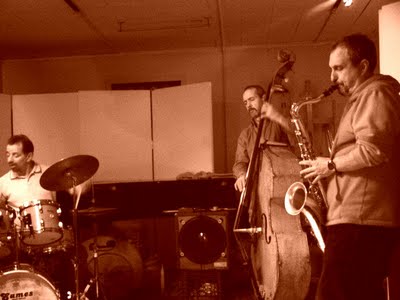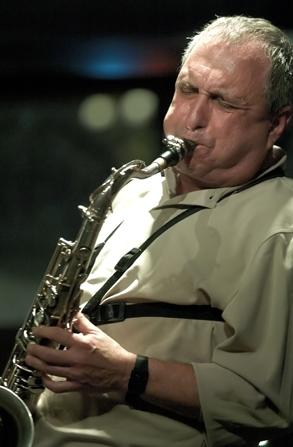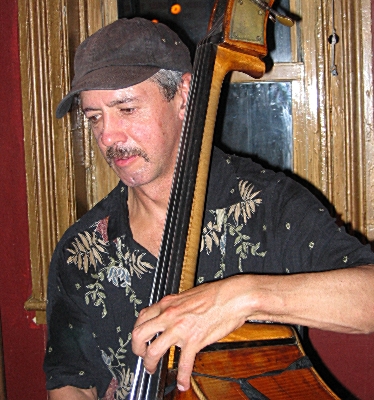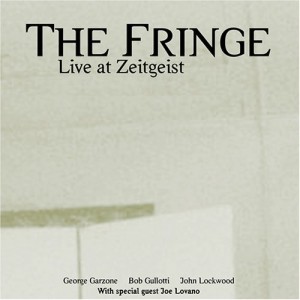Music Review/Commentary: The Fringe in Context — Boston Conservatory’s New Music Festival II
Boston Conservatory’s New Music Festival is inspiring a series of critical and speculative commentaries from Fuse Jazz Critic Steve Elman. Here is the second, which focuses on The Fringe and some of the qualities that make the trio special in the world of jazz.
By Steve Elman
Review/Commentary — Boston Conservatory’s New Music Festival, I
The Boston Conservatory’s New Music Festival put The Fringe at the center on December 3, and this trio, going on 40 years of cooperative playing, did not disappoint. Saxophonist George Garzone, bassist John Lockwood, and drummer Bob Gullotti played brilliantly, as they have every time I’ve heard them.
Festival director Eric Hewitt, himself a reed player with great respect for Garzone’s status as improviser and teacher, saw no disconnect between the “classical” works that usually occupy New Music stages and what is usually thought of as a pure jazz band. In his introduction from the stage, he noted that The Fringe is both a part of jazz and beyond it.
True that. But this concert’s title (The Future of the Church of Coltrane) and its mission were directly jazz-focused. The program promised four pieces associated with John Coltrane and “improvisations in the style of John Coltrane.” That The Fringe played only two of the promised tunes and chose to interpret the program’s mandate very broadly doesn’t mean that they didn’t fulfill it.
It does mean that an issue central to the aesthetic of The Fringe (that is, the legacy of John Coltrane) was out front for a change, and this gives me the chance to discuss not only what was played but also some of the qualities that make The Fringe special in the world of jazz.
Examine for a moment some of the wonderful things that have happened in this band’s 40-year history. When Garzone called me in 1972 and asked if he could bring his group to the WBUR studios and play on my radio show, I did not know who he was or what the band would sound like. I remember he told me that they had been working on a collective music for a year or so, that the band hadn’t really gotten much traction in the local clubs, and that he thought a radio appearance might help them get gigs. Okay by me, I said.
My memory of that first appearance was of an energy music that was similar to things I knew and yet very different from things I knew.
Around the same time, multi-instrumentalist Sam Rivers was working with only a bassist and drummer, and his concerts featured a fearless, high-octane approach without any tunes or prearranged structures. The Fringe drew something from this precedent without imitating it. The Coltrane influence was obvious in Garzone’s playing, but he also incorporated Pharoah Sanders-like screaming and a thoughtful, Sonny Rollins-ish approach to constructing his thoughts. Then-bassist Richard Appleman had a distinctive approach to arco playing and a huge sound; his overall direction put him somewhere in the neighborhood of Paul Chambers, Cecil McBee, and Charlie Haden. And Bob Gullotti played the drums like someone who had learned all the classic, hard-bop approaches to drumming and moved them forward into the future. I had never been so close to a free-jazz trio, and the fury with which they approached their music was thrilling and a little scary. I remember feeling exhausted when the set was over and wondering to myself, “That was great. But where can they take music this intense?”
Like so many of my judgments in those salad days, this one underestimated the capacity of musicians to define their own aesthetic and to grow on their own terms. The Fringe was lucky enough to land some regular, Monday night gigging, which became a tradition of constant renewal that they continue to this day at the Lily Pad gallery in Cambridge. They played at the Jazz All Night concerts. They came back to WBUR to perform again and again, and all of the BUR jazz crew (Tony Cennamo, Rob Battles, Ted Boccelli, myself) adopted them as a cause. They began to release LPs on their own label. Mirabile dictu, they began to make a living at music. Garzone generated notice as a soloist on his own, and he appeared as featured artist with Baird Hersey and the Year of the Year and George Russell’s Living Time Orchestra.
In 1985, Appleman decided that he couldn’t give the band the time it needed if he was going to be chair of the bass department at Berklee and also maintain his active schedule as a pit musician.
He was replaced by Capetown-born John Lockwood, a player I’d barely heard of, and the trio’s collective explorations moved forward without a perceptible hiccup. Local critics regularly referred to them as one of Boston’s most important groups and lauded them for staying close to home and not moving to New York. They got a commercial-label deal with the respected, Italian record company Soul Note. Garzone’s reputation as a monster-stylist grew and grew, and he began to get feature spots with a wide range of sympathetic players (Mike Maineri, Joe Lovano, Bob Moses, etc.) and recording gigs as a leader. He formulated his “triadic chromatic” approach to improvising and began to receive recognition as an educator as well as a front-rank jazzman. Lockwood (now with more than 100 recordings in his discography) and Gullotti (more than 60 recordings to date) got more and more sideman work and settled into highly-respected faculty roles at Berklee.
Not bad for a little trio from Beantown.
Still, whenever The Fringe is discussed, St. John is there. Garzone is predictably a “post-Coltrane stylist,” and the band is likened to “the Coltrane quartet without a piano.” If I may say, these descriptions amount to lazy criticism.
The emotional impact of The Fringe, what you feel when you hear them, is not at all what you feel when you hear Coltrane’s band. And Coltrane considered piano an almost indispensable part of his music, where the distinctive character of The Fringe comes precisely from its rejection of any chordal instrument as part of the group. (I know from listening and personal experience that putting piano, vibes, or guitar into The Fringe changes the character of their music profoundly.)
The real precedents for The Fringe are Sam Rivers’s trio (as mentioned previously—for comparison, listen to the tenor saxophone section of Rivers’s “Streams,” from 1973) and Sonny Rollins’s “East Broadway Run Down,” from 1966, where Rollins plays with half of Coltrane’s working band, bassist Jimmy Garrison, and drummer Elvin Jones. And even in these cases, where the lack of a chordal foundation gives the saxophonist free range to slip and slide harmonically, the sections don’t work in the way that Lockwood and Gullotti do. The Fringe’s bass-drum interplay is much more like that of Ornette Coleman’s rhythm section of Charlie Haden and Billy Higgins than it is like Coltrane’s team. To seal the not-Coltrane deal (and for anyone who really wants to compare The Fringe with anyone else), Coltrane’s one recording with Ornette’s men (“The Avant-Garde,” with Don Cherry), though fascinating, is generally considered one of his least successful.
I want to point out one more way in which The Fringe are distinctive, one way that brings them back to Hewitt’s definition, one way in which they will never be properly served by recordings: the whole of a Fringe performance is always greater than the sum of its parts. A concert by the Fringe tells a story in the way that a great jazz solo tells a story. The story has dramatic sweep, ebb and flow, whispers, asides, fascinating digressions, high-tension oratory, character development, tender caresses, and a couple of jokes. Those things you feel are delight at being able to ride along with them and amazement that three human beings can think together so beautifully. When a performance ends, you feel you have been transported from where you were to where you are, and you sense the distance that you have traversed. Of course, these kinds of transitions are going on in every life, all the time. The Fringe simply makes you aware of how immense they are.
The story they told at TBC’s theater on December 3 was particularly interesting because of the scenery. Imagine that a great portrait of John Coltrane hung behind The Fringe as a kind of stage dressing—it wasn’t actually there, but anyone could see it if he or she tried. The drama played out in front of the portrait, with an occasional nod to it, but without a sense of memorial or obeisance. Garzone, Lockwood, and Gullotti began with Coltrane’s “Crescent,” which they played in something of a pre-arranged way (Lockwood seemed to be reading the changes from sheet music, so the tune may not be a regular in their book.) Rubato introduction, then the theme statement over gradually coalescing rhythm, Garzone’s solo, Lockwood’s solo, and then a series of breaks between Garzone and Gullotti that started as 12-bar units and gradually became more and more an open-ended conversation between the two, resolving to the theme statement more or less as the tune began.
Then a drum solo led off into true Fringe territory. For several minutes, the three players actually phrased together—it was not a tenor saxophone solo with accompaniment but a series of group statements. Lockwood’s second bass solo brought the band into more balladic territory. Gullotti went to his brushes. Another series of those group statements. A lovely, subtle drum solo with brushes that had me thinking of Philly Joe Jones. Then Garzone a capella, at first in his own distinctive waves of arpeggiated harmony, followed by three fierce honks that ushered in split tones and vocal effects. Lockwood and Gullotti back in, then taking over for a bass-drum conversation while Garzone switched to soprano. More group phrasing, into which Lockwood introduced a repetitive pattern with a strong root note, and we broke into Coltrane exotica-land.
The tune wasn’t exactly “India” or “Africa” or “Ole,” but that strong, modal, near ostinato was a nod to one of Coltrane’s favorite devices. Garzone had a passionate few minutes on soprano, and then Lockwood turned in a superlative solo, using the root note and double-stops, with a hint-quote of the “Love Supreme” bass line. Gullotti dropped his sticks and used his hands on his traps as the bass solo came to an end and then slipped into his own solo with his hands alone, hinting at tabla and talking drums. Garzone and Lockwood came back in, Gullotti switched to mallets, and the group eased away from exotica. Lockwood took another solo, gradually doubling the tempo. Gullotti switched over to sticks and started a solo with a long series of soft, rapid-fire pulses on his bass drum, finally exploding over them. Garzone picked up his tenor and duetted with Gullotti. Lockwood came back in, and the free-for-all, now at high intensity, coalesced into one of The Fringe’s fanfare heads.
A pause for applause.
Garzone began Billy Eckstine’s “I Want to Talk about You” without accompaniment. This tune, memorably part of Coltrane’s 1958 “Soultrane” session and recorded several more times in concert in 1963, has become one of Garzone’s favorite showcases for solo playing. Coltrane’s 1963 versions all feature long, solo cadenzas just before the final chord, and Garzone is unashamed of the precedent. In performing this tune, he is perhaps most directly paying homage to St. John, but his decorations feel different to me. Coltrane never forgot that this is a classic ballad, and he returned to the chords repeatedly as touchstones. Garzone’s approach is even more decorative than Coltrane’s, and he fills the space with so many notes that the chords sometimes disappear. Still, his overall feel is usually more melancholy and elegiac than Coltrane’s was, and this was no exception. When Lockwood and Gullotti came in, they kept the ballad feel—Lockwood’s solo was beautifully sung, and Gullotti played his with brushes, leaving plenty of breathing room. Garzone came back for the theme statement, reducing the theme to as few notes as possible, each one carefully chosen and positioned. Finally, another solo sax cadenza and the concluding chord.
End of first set—an hour of music had flashed by.
Gullotti opened the second set establishing a fast tempo that promised “Chasin’ the Trane,” but the tune as such never materialized. The head, such as it was, seemed to be a series of long tones over that tempo. Each of the players burned through their solo spots. The long-tone head appeared again, sort of, and the tempo subsided, with Lockwood moving into a tango feel. As Garzone played smokily on this foundation, I was sure they had segued to a standard I just couldn’t identify, but Lockwood told me later it was impromptu, just a combination of familiar chords. After a bass solo, Garzone concentrated on his split tones and then on puffs of toneless air through the sax as a setup and background to Gullotti’s mallet solo, which began rumbly and meditative, then exploded. The tango finally reasserted itself, and the band took a pause.
The finale was a full-throttle Fringe onslaught. Garzone led off with honks and scalar figures, the tempo jumped way up, and the three went into a whirlwind. The scales kept coming back in Garzone’s playing until he hit on the repetition of two notes, adding enough overtone to simulate the see-sawing siren of a European emergency vehicle. He held on to this motif for almost a full minute, with only a tiny break, as Lockwood and Gullotti boiled under him. Then it was over.
Called back for an encore, The Fringe essentially did a fast-forward reprise of what they’d just played. Solo sax at a furious tempo, then a smiling glance between Lockwood and Gullotti, and another knock-down-the-walls group improv.
Not bad for a little trio from Beantown.
Additional Information on The Fringe
The Fringe’s website — note, however, that it hasn’t been updated in a quite a while.
George Garzone’s website.
The Lily Pad’s website.
A Fringe discography, possibly incomplete:
with Richard Appleman on bass:
The Fringe (Ap-Gu-Ga, 1978)
Live! (Ap-Gu-Ga, recorded at Berklee Performance Center, 9/30/1980)
Hey, Open Up! (Ap-Gu-Ga, 1983; with pianist Ran Blake on one track)
with John Lockwood on bass:
Return of the Neanderthal Man (Popular Arts, 1990)
It’s Time for the Fringe (Soul Note [Italy], 1992)
Live in Israel (Soul Note [Italy], 1997)
Live in Iseo (Soul Note [Italy], 1992)
The Fringe in New York (NYC, 2000; with vibraphonist Mike Maineri)
[note: on sales sites, this recording is usually listed as a Garzone session]
Live at Zeitgeist (Resolution, 2005; with saxophonist Joe Lovano)
Other recordings referred to here:
Sonny Rollins: East Broadway Run Down (Impulse, 1966)
John Coltrane and Don Cherry: The Avant-Garde (Atlantic, 1966 [recorded 1960])
Sam Rivers: Streams – Live at the Montreux Jazz Festival (Impulse, 1973)
John Coltrane: Soultrane (Prestige, 1958); Live at Birdland (Impulse, 1963);
Selflessness (Impulse, 1968 [recorded 1963 and 1965]);
Afro-Blue Impressions (Pablo, 1977 [recorded 1963])
— Steve Elman
Tagged: Bob Gullotti, Boston-Conservatory, Eric Hewitt, George Garzone, John Lockwood, New Music Festival, The Fringe







Thanks so much, Steve!!!